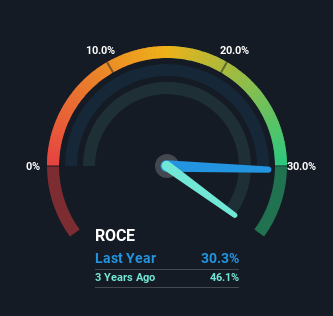- Japan
- /
- Professional Services
- /
- TSE:9216
Some Investors May Be Worried About Bewith's (TSE:9216) Returns On Capital

Finding a business that has the potential to grow substantially is not easy, but it is possible if we look at a few key financial metrics. Firstly, we'd want to identify a growing return on capital employed (ROCE) and then alongside that, an ever-increasing base of capital employed. This shows us that it's a compounding machine, able to continually reinvest its earnings back into the business and generate higher returns. So when we looked at Bewith (TSE:9216), they do have a high ROCE, but we weren't exactly elated from how returns are trending.
What Is Return On Capital Employed (ROCE)?
If you haven't worked with ROCE before, it measures the 'return' (pre-tax profit) a company generates from capital employed in its business. To calculate this metric for Bewith, this is the formula:
Return on Capital Employed = Earnings Before Interest and Tax (EBIT) ÷ (Total Assets - Current Liabilities)
0.30 = JP¥2.8b ÷ (JP¥13b - JP¥3.9b) (Based on the trailing twelve months to February 2024).
Thus, Bewith has an ROCE of 30%. In absolute terms that's a great return and it's even better than the Professional Services industry average of 16%.
See our latest analysis for Bewith

In the above chart we have measured Bewith's prior ROCE against its prior performance, but the future is arguably more important. If you're interested, you can view the analysts predictions in our free analyst report for Bewith .
What Can We Tell From Bewith's ROCE Trend?
On the surface, the trend of ROCE at Bewith doesn't inspire confidence. Historically returns on capital were even higher at 46%, but they have dropped over the last three years. Although, given both revenue and the amount of assets employed in the business have increased, it could suggest the company is investing in growth, and the extra capital has led to a short-term reduction in ROCE. If these investments prove successful, this can bode very well for long term stock performance.
On a related note, Bewith has decreased its current liabilities to 30% of total assets. That could partly explain why the ROCE has dropped. What's more, this can reduce some aspects of risk to the business because now the company's suppliers or short-term creditors are funding less of its operations. Some would claim this reduces the business' efficiency at generating ROCE since it is now funding more of the operations with its own money.
Our Take On Bewith's ROCE
In summary, despite lower returns in the short term, we're encouraged to see that Bewith is reinvesting for growth and has higher sales as a result. And there could be an opportunity here if other metrics look good too, because the stock has declined 16% in the last year. As a result, we'd recommend researching this stock further to uncover what other fundamentals of the business can show us.
Bewith does have some risks though, and we've spotted 1 warning sign for Bewith that you might be interested in.
If you want to search for more stocks that have been earning high returns, check out this free list of stocks with solid balance sheets that are also earning high returns on equity.
Valuation is complex, but we're here to simplify it.
Discover if Bewith might be undervalued or overvalued with our detailed analysis, featuring fair value estimates, potential risks, dividends, insider trades, and its financial condition.
Access Free AnalysisHave feedback on this article? Concerned about the content? Get in touch with us directly. Alternatively, email editorial-team (at) simplywallst.com.
This article by Simply Wall St is general in nature. We provide commentary based on historical data and analyst forecasts only using an unbiased methodology and our articles are not intended to be financial advice. It does not constitute a recommendation to buy or sell any stock, and does not take account of your objectives, or your financial situation. We aim to bring you long-term focused analysis driven by fundamental data. Note that our analysis may not factor in the latest price-sensitive company announcements or qualitative material. Simply Wall St has no position in any stocks mentioned.
Have feedback on this article? Concerned about the content? Get in touch with us directly. Alternatively, email editorial-team@simplywallst.com
About TSE:9216
Bewith
Provides contact/call centers and BPO services utilizing digital technologies in Japan.
Excellent balance sheet average dividend payer.
Market Insights
Community Narratives




